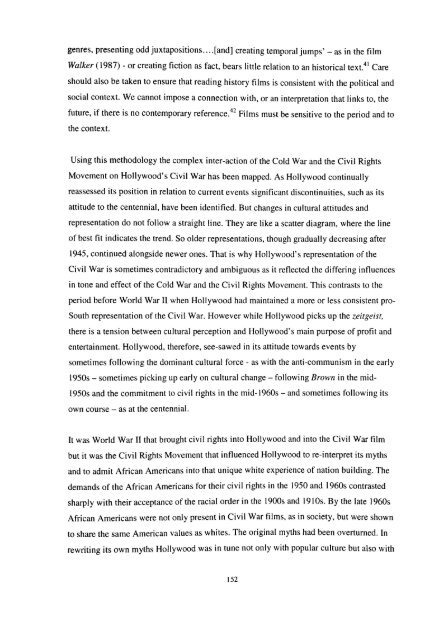Download (3483kB) - Greenwich Academic Literature Archive ...
Download (3483kB) - Greenwich Academic Literature Archive ...
Download (3483kB) - Greenwich Academic Literature Archive ...
- No tags were found...
Create successful ePaper yourself
Turn your PDF publications into a flip-book with our unique Google optimized e-Paper software.
genres, presenting odd juxtapositions.... [and] creating temporal jumps' - as in the filmWalker (1987) - or creating fiction as fact, bears little relation to an historical text.41 Careshould also be taken to ensure that reading history films is consistent with the political andsocial context. We cannot impose a connection with, or an interpretation that links to, thefuture, if there is no contemporary reference. 42 Films must be sensitive to the period and tothe context.Using this methodology the complex inter-action of the Cold War and the Civil RightsMovement on Hollywood's Civil War has been mapped. As Hollywood continuallyreassessed its position in relation to current events significant discontinuities, such as itsattitude to the centennial, have been identified. But changes in cultural attitudes andrepresentation do not follow a straight line. They are like a scatter diagram, where the lineof best fit indicates the trend. So older representations, though gradually decreasing after1945, continued alongside newer ones. That is why Hollywood's representation of theCivil War is sometimes contradictory and ambiguous as it reflected the differing influencesin tone and effect of the Cold War and the Civil Rights Movement. This contrasts to theperiod before World War II when Hollywood had maintained a more or less consistent pro-South representation of the Civil War. However while Hollywood picks up the Zeitgeist,there is a tension between cultural perception and Hollywood's main purpose of profit andentertainment. Hollywood, therefore, see-sawed in its attitude towards events bysometimes following the dominant cultural force - as with the anti-communism in the early1950s - sometimes picking up early on cultural change - following Brown in the mid-1950s and the commitment to civil rights in the mid-1960s - and sometimes following itsown course - as at the centennial.It was World War II that brought civil rights into Hollywood and into the Civil War filmbut it was the Civil Rights Movement that influenced Hollywood to re-interpret its mythsand to admit African Americans into that unique white experience of nation building. Thedemands of the African Americans for their civil rights in the 1950 and 1960s contrastedsharply with their acceptance of the racial order in the 1900s and 1910s. By the late 1960sAfrican Americans were not only present in Civil War films, as in society, but were shownto share the same American values as whites. The original myths had been overturned. Inrewriting its own myths Hollywood was in tune not only with popular culture but also with152
















